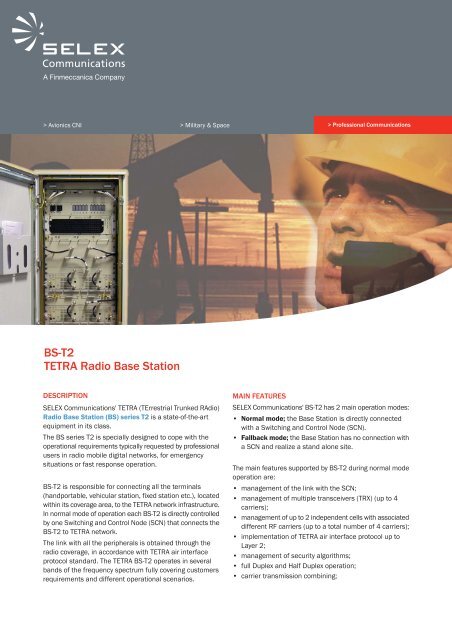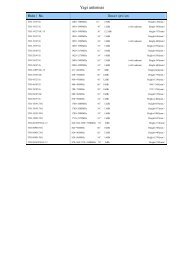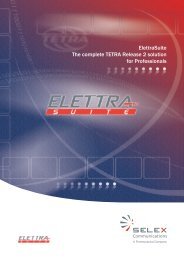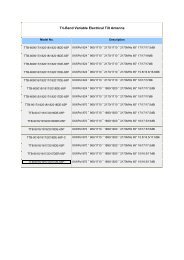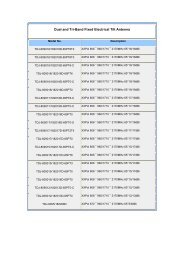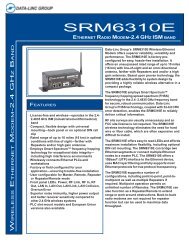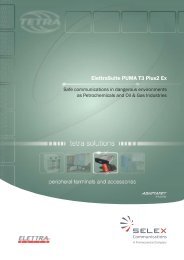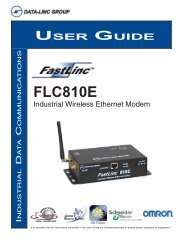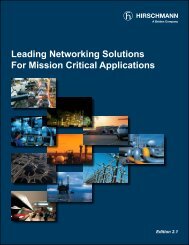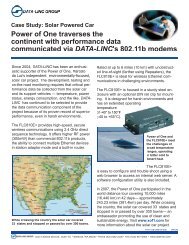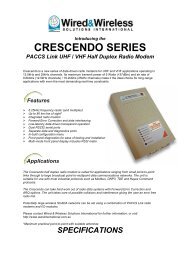BS-T2 TETRA Radio Base Station
BS-T2 TETRA Radio Base Station
BS-T2 TETRA Radio Base Station
- No tags were found...
Create successful ePaper yourself
Turn your PDF publications into a flip-book with our unique Google optimized e-Paper software.
Avionics CNI > Military & Space> Professional Communications<strong>BS</strong>-<strong>T2</strong><strong>TETRA</strong> <strong>Radio</strong> <strong>Base</strong> <strong>Station</strong>DESCRIPTIONSELEX Communications' <strong>TETRA</strong> (TErrestrial Trunked RAdio)<strong>Radio</strong> <strong>Base</strong> <strong>Station</strong> (<strong>BS</strong>) series <strong>T2</strong> is a state-of-the-artequipment in its class.The <strong>BS</strong> series <strong>T2</strong> is specially designed to cope with theoperational requirements typically requested by professionalusers in radio mobile digital networks, for emergencysituations or fast response operation.<strong>BS</strong>-<strong>T2</strong> is responsible for connecting all the terminals(handportable, vehicular station, fixed station etc.), locatedwithin its coverage area, to the <strong>TETRA</strong> network infrastructure.In normal mode of operation each <strong>BS</strong>-<strong>T2</strong> is directly controlledby one Switching and Control Node (SCN) that connects the<strong>BS</strong>-<strong>T2</strong> to <strong>TETRA</strong> network.The link with all the peripherals is obtained through theradio coverage, in accordance with <strong>TETRA</strong> air interfaceprotocol standard. The <strong>TETRA</strong> <strong>BS</strong>-<strong>T2</strong> operates in severalbands of the frequency spectrum fully covering customersrequirements and different operational scenarios.MAIN FEATURESSELEX Communications' <strong>BS</strong>-<strong>T2</strong> has 2 main operation modes:• Normal mode; the <strong>Base</strong> <strong>Station</strong> is directly connectedwith a Switching and Control Node (SCN).• Fallback mode; the <strong>Base</strong> <strong>Station</strong> has no connection witha SCN and realize a stand alone site.The main features supported by <strong>BS</strong>-<strong>T2</strong> during normal modeoperation are:• management of the link with the SCN;• management of multiple transceivers (TRX) (up to 4carriers);• management of up to 2 independent cells with associateddifferent RF carriers (up to a total number of 4 carriers);• implementation of <strong>TETRA</strong> air interface protocol up toLayer 2;• management of security algorithms;• full Duplex and Half Duplex operation;• carrier transmission combining;
• 2-way diversity reception capability;• radio frequency (RF) duplex capability to transmit andreceive on the same antenna;• fault management relevant to external interfaces (suchas those supporting the SCN link) and internal modulesfailures;• status monitoring of internal modules and interface cards;• alarms report to Network Management System (NMS)and <strong>BS</strong>-<strong>T2</strong> Local Terminal;• events and alarms log;• capability to collect site alarms and drive actuators;• maintenance and configuration operations both locallyand remotely;• diagnostic testing activities, using specially devoted tools,to identify potential anomalies within the equipment.In case of a failure in the link interconnecting the <strong>BS</strong>-<strong>T2</strong> withthe SCN (or in case of a single site deployment without SCN)the <strong>BS</strong>-<strong>T2</strong> automatically switches to fallback mode.In this operation mode the base station provides users,within the radio coverage, with the following services:• half and full duplex individual call (both voice and datatransfer);• group call (both voice and data transfer);• emergency calls;• short data message service;• multi-slot (up to 4 slots) circuit mode data.The <strong>BS</strong>-<strong>T2</strong> is specifically designed in order to support a highlevel of performance on a 24 hours a day basis, also in caseof failure of some of the internal modules or of networkinfrastructure. The high level of fault tolerance is obtaineddue to the following peculiar features of <strong>BS</strong>-<strong>T2</strong>:• modular architecture;• redundancy of major modules and main power supply;• capability of self-reconfiguration in case of failures;• capability of working in a stand-alone mode without thelink with the SCN;• capabilities of working also without main power supply(220 VAC).In each site an external UPS (Uninterruptible Power Supply)is available, and it is equipped with a battery pack suitablysized. During normal conditions, the UPS connected to theAC power supply will supply the <strong>BS</strong>-<strong>T2</strong> (-48 VDC) and willcharge the battery pack so that, in case of the main powersupply failure, the batteries provide proper supply to the <strong>BS</strong>-<strong>T2</strong>.<strong>BS</strong>-<strong>T2</strong> is usually delivered with at least two transceivers inorder to provide transceiver fault tolerance.Each transceiver has its own power supply module, andtherefore there is not any dependence among radiotransceivers.TECHNICAL DATAPower class (hybrid configuration,max 2 carriers per antenna):Power range:Frequency band:Duplex spacing:Diversity:Power supply:Bandwidth:Environmental aspects:Power consumption:Class 2 (EN 300 392-2) 44 dBm (25 W), ±2 dB according to ETSI EN 300 394-1 at antenna connectors10 dB (2 dB steps)<strong>BS</strong>-400: 380 to 400 MHz / <strong>BS</strong>-430: 410 to 430 MHz / <strong>BS</strong>-470: 450 to 470 MHz / 800 MHz10 MHz2 ways-48 VDC nominal (positive ground), range -44 to -60 VDC5 MHz• Operation: ETSI ETS 300 019-1-3, class 3.1E• Storage: ETSI ETS 300 019-1-1, class 1.2• Transportation: ETSI ETS 300 019-1-2, class 2.2• EMC: Compliant to ETSI EN 301 489-18• TSU-200: 200W max. at 48 VDC for redundant configuration• TTU: 300W max. for each TRX, at 48 VDCe-mail: info@selex-comms.com • www.selex-comms.comCopyright ©2007-2009 SELEX Communications SpA - All rights reserved.This publication is issued to provide outline information only which (unless agreed by SELEX CommunicationsSpA in writing) may not be used, applied or reproduced for any purpose or form part of any order or contract orbe regarded as a representation relating to the products or services concerned. SELEX Communications SpAreserves the right to alter without notice the specification, design or conditions of supply of any product or service.SELEX Communications logo is a trademark of SELEX Communications SpA.Printed in Italy. e-P-IT-293/V2/09/Y


